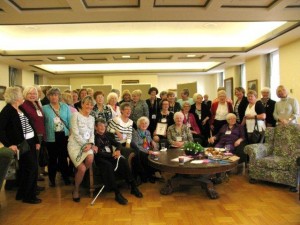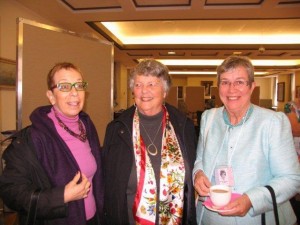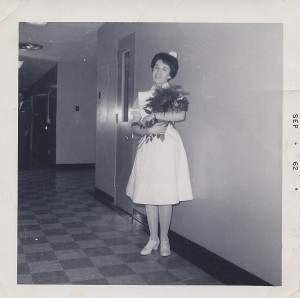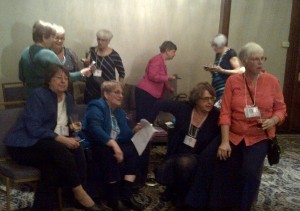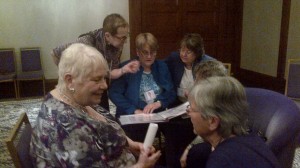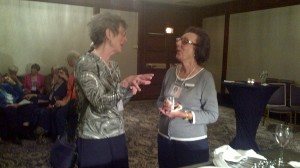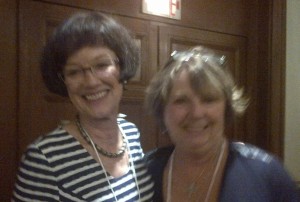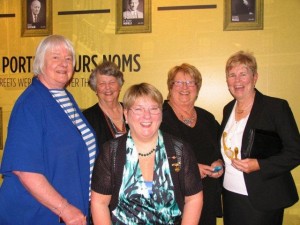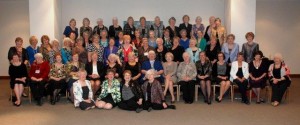This piece was first published in The Women’s Almanac in 1993. Muriel passed away in 2009.
MURIEL DUCKWORTH was born in 1908 on a farm in Quebec near the town of Austin. She graduated from McGill University in Montreal in 1929. She and her husband lived in Montreal and in New York before moving to Nova Scotia in 1949. Much of her work has been in adult education but she is best known as one of Canada’s most distinguished feminists and pacifists. She was a founding member of the Voice of Women (Nova Scotia) and served as national president from 1967-1971. She is also a founding member of 17 other national and provincial organizations, including the Canadian Research Institute for the Advancement of Women (CRIAW), the Canadian Conference on the Family (out of which came the Vanier Institute on the Family), and the Nova Scotia Women’s Action Coalition. She has run for public office (with the federal New Democratic Party) and has attended women’s conferences for peace around the world. She is a member of the Order of Canada, and has been awarded six honourary degrees. In 1991, she was the recipient of the Lester B. Pearson Peace Medal. She has three children, eleven grandchildren and three great-grandchildren. This story is told in Muriel’s own words.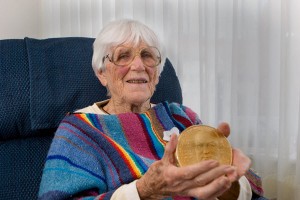
=================================================================
My mother was a very independent person with ideas that she always expressed. I remember a lot of arguments in the family because my mother had her point of view and it was always taken for granted that she would have. I suppose I’ve become like that.
She always earned money, by turning the farmhouse into a summer boarding house – she was a very good cook – and then when they moved from the farm into the village, she always boarded the teachers or young men working in the bank. Then she opened what she called a tearoom – it was a really attractive little place and we all worked there in the summers.
She also became a representative of the Travellers’s Aid, because we lived a block from the railstation – if any young women arrived not knowing where they were going or what to do, the station agent would send them to my mother.
There was no library in the town at that time. We didn’t have many books but the ones we had, she took the china out of the china cabinet and put the books in there and made a little book plate and had a little library.
She even wrote letters to the editor. That really got her into trouble! She was very active in the WCTU (Women’s Christian Temperance Union) which used to be a source of great amusement. When I was at McGill, I wouldn’t have had anybody know my mother was active in the WCTU – everybody would laugh. After I became involved in the women’s movement and women were doing research about Canadian women, they began giving credit to the WCTU for what they had done.
It changed my thinking and I felt very stupid that I hadn’t seen it before because they were among the groups that had worked for votes for women and were well-supported and they really had a cause: temperance was an important social issue. Women were very angry how women and children were suffering while men were getting drunk.
My own mother must have been inspired by her mother. There is a connection between generations. I’m sure I leaned toward working with women because of my mother and grandmother. They say my grandmother was a wonderful teacher. She kept a blackboard in the kitchen so she could teach her children – she had a large family. I knew her though she died when I was quite young. She taught me to read.
I was the first one in my family to go through university.
Education was very important to my parents although neither one of them had a lot.
So I did go to McGill. As far as I know, only two women from that town ever went to university.
* * *
During World War Two, my younger brother went to war and of course, that was a terrible worry for my mother. He was much younger than the rest of us; it was awful to see him go off to war and he was killed.
But from the beginning, my husband Jack and I were opposed to the war and that was not a very common position to take. When the war broke out in 1939, Jack was already 42, so you know, he had seen war before – I had lived through the First World War as a child, but he had lived through it as an adult. He had done a lot of thinking about it and there was a very strong pacifist movement between the wars. My mother and father, of course, supported the war and they were very upset when we didn’t. My mother used to get very angry about that.
It was hard to defend pacifism during the Second World War. I could do it better now than I could then. The war didn’t have to be fought. It could have been dealt with earlier. That’s my conviction.
I’ve just read an article about what happened leading up to the Gulf war with Iraq and it’s shocking what happened with the rest of the world arming Iraq and then complaining about its nuclear capacity. That’s the kind of thing I mean.
* * *
The Voice of Women grew out of the fear of the nuclear testing in the ’50s. The fallout from the testing was what got people thinking first. The women opposed that from the very beginning.
No one in the peace movement can really point to something and say “we did that” and you know that there were other factors – political factors – but there was also this real uprising of people when they began to see the films of what was happening in the US with the testing above ground. Then we began to realize that testing below ground wasn’t so great either.
Around the country, there were already women on the verge of organizing a women’s peace group and when it happened, women poured into the membership, because it was such a dangerous time. The women who had come here as war brides were just beside themselves because they couldn’t bear the thought of another war.
Our annual meetings were very emotional because there was so much fear. This was around 1960.
The Cuban crisis was in 1962 but before that it was the spy plane, the U2 over the Soviet Union that nearly caused a crisis. Then there was the fallout that was evident all across Canada from testing in the US causing the strontium-90 in milk.
* * *
I connect the kind of violence that we see in our cities and in our homes with the ultimate dependence of the state on violence as a solution.
I don’t think people recognize that war is the greatest destroyer of human life, the greatest polluter, the greatest creator of refugees, the greatest cause of starvation and illness. Look at Iraq. The children of Iraq had a good health system and now, five times as many children are dying from diseases they shouldn’t be dying from – because of the war.
The rape of women has always been a consequence of war, still is: the setting up of prostitute cities in the Philippines near where the soldiers are, in Honduras where the soldiers were crossing into Nicaragua, all over the world… the Korean women in Japan.
When I was president of the Voice of Women – this was in 1967-1970 – I phoned around to the columnists I knew to see who would link the money going into armaments with the lack of money for all the other things that people need. Nobody would. They said there hadn’t been any studies done.
Today, you sometimes hear one who makes the link, who says this is a disgrace. Even men are now sometimes saying that – women have been saying it for years: why are we spending two billion dollars on submarines for Canada when we can’t keep the schools supplied with enough teachers? What you could do with that two billion dollars to make a good society!
When the government wanted to take the country to war, it could suddenly find millions of dollars a day to fight in the Gulf. War is the only emergency that people recognize – that the state recognizes and that it can sell to the people.
* * *
Halifax is very much a military town and I’ve always had crank letters and phone calls. People wouldn’t speak to me on the street.
You can’t do this kind of work alone. You’re with a whole lot of other people doing it and that’s where I’ve always got my strength. I think groups who are seeking change are now recognizing each other as being part of the same thing – black groups, women’s groups, single mother’s groups, the environmental groups, anti-poverty – all these groups are recognizing each other and working together.
In a way the VoW has changed because we now function much more loosely – we want to have a sense of what all women in the VoW are thinking.
From the start here in Nova Scotia we had a two-track mandate: one was peace, the other was human rights. When we started with human rights, it was for black people – we did research, we had public meetings and we did as much as we could. Now, that’s not appropriate; the black people are doing it themselves and that’s as it should be.
We’re not writing as many briefs to government as we used to write. There’s a real question in everyone’s minds whether that’s an effective way to function. We’re much smaller than we were at first. We have perhaps 1500 women across Canada now.
There was a resurgence of interest during the Gulf war. People did a lot of protesting. I used to get very angry at the media because they’d say, “where’s the peace movement?” The peace movement was there before the war started but they weren’t paying any attention. It’s still there and they’re not paying attention.
There’s a lot of environmental emphasis in the VoW now and a lot of human rights emphasis and a lot better understanding of economics and of power structures than we had at first. We’ve always been a very wide-ranging group. Some women, in the very beginning were politically conscious and had very well-developed thinking about what was going on in the world – but a lot of us didn’t. We were just there because we couldn’t stand the idea that there might be another war.
We’ve become much more feminist. We no longer have the argument that we used to have when people would say, “well, maybe we should change our name to Voice of People or take men into the membership.” I don’t think anybody ever suggests that anymore. It’s a hard question about whether women have made significant gains in my lifetime. I’ve begun to take a hard view of history and I’m not sure you can say what progress is. There’ve always been great women but I think the progress is that a lot more women have confidence in themselves and a lot more women rely on each other and are taking action to change their conditions.
But to take a world view, women are still doing 90 per cent of the world’s work and are mostly without power.
So many of our children, around the world, have been so damaged and have been left with such a damaged environment, that I sometimes take a pessimistic view of the future. I don’t know what kind of life future generations of women will have.
I think you just have to put your faith and trust in people. I don’t use the word love but we all have to care – not just for our own little circle, but for the universe.







